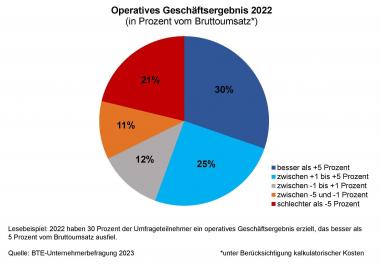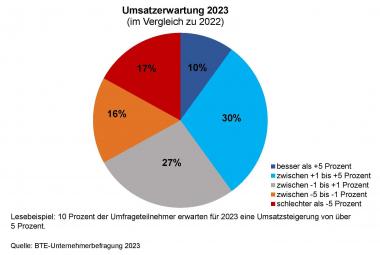Zu viele Händler 2022 in den roten Zahlen
2022 war für viele Textil-, Schuh- und Lederwarenhändler ein sehr durchwachsenes Jahr. Nach der aktuellen BTE-Unternehmerumfrage aus dem Januar 2023 haben im letzten Jahr zwar drei von zehn Modehändlern ein operatives Geschäftsergebnis erzielt, dass besser als + 5 Prozent vom Bruttoumsatz ausfiel (unter Berücksichtigung kalkulatorischer Kosten), bei einem Viertel der Umfrageteilnehmer lag der Ertrag aber lediglich zwischen + 1 und + 5 Prozent.
Problematisch: 12 Prozent erreichten lediglich ein halbwegs ausgeglichenes Ergebnis zwischen +1 und -1 Prozent. Und ein knappes Drittel der Umfrageteilnehmer landete tief in den roten Zahlen, jeder fünfte sogar mit einem operativen Verlust von 5 Prozent oder schlechter.
"Nach zwei hochproblematischen Corona-Jahren mit zum Teil hohen betriebswirtschaftlichen Verlusten ist die vollständige Rückkehr zur Normalität bei einem Gutteil der Unternehmen damit noch nicht erreicht", konstatiert BTE-Hauptgeschäftsführer Rolf Pangels. Die Gründe sind mit dem Ukraine-Krieg und den damit verbundenen Kostenbelastungen zwar primär externer Natur, letztendlich müssen die Unternehmen die Folgen aber verkraften. Pangels: "Angesichts der wohl weiter steigenden Kosten und gleichzeitig unsicheren Umsatzentwicklung dürften rund die Hälfte der Unternehmen Probleme haben oder bekommen, notwendige Investitionen in ihre Wettbewerbsfähigkeit zu tätigen."
Vor diesem Hintergrund ist der Textil-, Schuh- und Lederwarenhandel zurückhaltend bezüglich seiner Umsatzerwartung für 2023. Nur eine Minderheit von 40 Prozent der Umfrageteilnehmer rechnet mit einem nennenswerten Umsatzplus gegenüber 2022. Bei etwa Pari (-1 bis +1 Prozent) sehen sich 27 Prozent der Teilnehmer. Rund ein Drittel befürchtet dagegen einen Rückgang von mindestens ein Prozent, die Hälfte davon sogar ein Minus von mindestens fünf Prozent.
BTE Handelsverband Textil Schuhe Lederwaren









